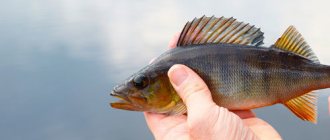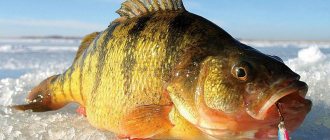Giant sunfish - 3 meters long
This fish, a species of sunfish, was discovered as recently as 2014. And therefore, little is known about her lifestyle. What is clear is that this is one of the largest fish in the world. And the heaviest, because it weighs up to 2 tons, which is comparable to the weight of an adult elephant.
Mola tecta, as scientists have named it, is the first new species of sunfish discovered in 130 years.
Caught a fish! 6 biggest catches in history
Fishermen are a gambling people and often love to lie. The most popular fishing tale is about the size of the fish that were caught. But there are fishermen who didn’t have to make up anything. With their record catches, they made history. Fate, luck, or the result of hard work and patience? Probably a little bit of everything. The main thing is the result.

Tuna to all the tuna
In the fall of 1979, Canadian Ken Fraster went on a regular fishing trip to Olds Cove Bay. The man did not even suspect that this day would become a turning point in his life, and he would go down in history. He didn’t even immediately realize what a weight suddenly pulled his fishing rod to the bottom. There were even suspicions that the hook got caught on a snag. Imagine Ken's amazement when he saw what kind of animal he had taken the bait. It took the Canadian more than 40 minutes to hook and drag the giant tuna into the boat. He had to wear the fish down pretty hard before it gave up. The weight of the caught dance was 678 kilograms. In order to record the record, an entire commission had to be invited. Before, no one had managed to catch a tuna whose weight exceeded 450 kilograms.
Read: Little-known and interesting facts about salmon
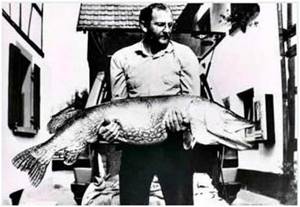
By magic
A pike of record size and weight was caught by German Lothar Lewis. The weight of the fish was 25 kilograms. Although, an adult fish often reaches a maximum weight of 16 kilograms. It is worth noting that there have long been legends about the German Lake Greffen, where this fisherman got lucky. Including the giant pikes that live there. However, only Lothar has managed to catch one so far.

Blue Dream
Brazilian Paulo Arim was simply fishing off the coast of Victoria, not suspecting that very soon he would have to enter into a difficult duel that lasted almost an hour and a half. And the reason was a gigantic Atlantic blue marlin. The weight of the fish was 635 kilograms.

Tiger hunt
Tiger fish is considered a real thunderstorm in African waters. Thanks to its powerful jaws and strong teeth, this fish can even make a crocodile, not to mention a human, its prey. However, in 1988, fishing traveler Raymond Houtsman decided to try his luck, and he succeeded. The weight of the dangerous specimen he caught was 44 kilograms.
Read: Taimen more than two meters long
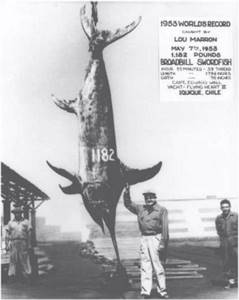
Who will come to us with a sword...
Swordfish are not only dangerous to marine life and small floating vessels. It is also capable of reaching speeds of up to 130 kilometers per hour. Therefore, catching her is very difficult. But on May 7, 1953, Chilean fisherman Lou Maron did not waste two hours of his life. His trophy was a fish almost five meters long and weighing 536 kilograms.

Old man on a hook
In 2009, the Japanese Manabu Kurita woke up famous not only due to the size and weight of the perch he caught. Although, on average, the weight of this fish is 2-3 kilograms, and Manabu Kurita’s catch weighed as much as 10. When the perch was examined by specialists, it turned out that its age was 80 years! This is despite the fact that on average, river perch lives 23-25 years. The perch caught by the Japanese was recognized as the oldest fish that was caught.
Common sharptail sunfish - 3.4 m
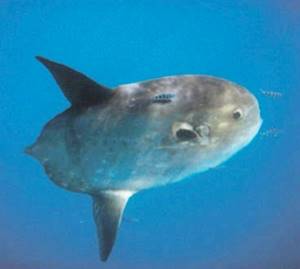
For residents of Korea, Japan and Taiwan, this sea giant is a delicious delicacy. In honor of the sharp-tailed sunfish, Taiwan even hosts large-scale culinary festivals that attract hundreds of tourists. It’s unlikely that the fish itself is happy about this, but who asks the food’s opinion?
Due to the characteristic shape of its fins, this good-natured and clumsy fish is sometimes confused with a shark. But it is difficult to confuse the sharp-tailed sunfish with others, due to the special shape of the tail. It looks like a pointed protrusion.
8. Beluga - 4.2 m
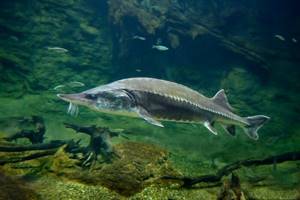
The largest freshwater fish is ready to “roar like a beluga,” as it is endangered. The beluga's habitat is limited to the Black, Caspian and Azov seas. People intensively exploit this species to obtain black caviar, a very expensive and rare delicacy.
Unregulated fishing of this species and poaching have significantly reduced beluga populations, leading to an urgent need to protect them from commercial exploitation.
By the way, the expression “beluga roar” is actually associated with another predatory fish - the beluga toothed whale.
According to unconfirmed information, belugas can grow much larger than 4 and even 5 meters. The largest specimen allegedly reached 9 meters.
Beluga
Belongs to the sturgeon family of the ray-finned fish class. It preferably spends most of its life in the waters of the Black and Azov Seas, and is found in the Caspian and Adriatic. It comes to the freshwater reservoirs of the Volga, Dniester, Don and their tributaries during spawning.
The structure of the body is cartilaginous without a spine, cylindrical in shape, covered with small diamond-shaped scales. The color is dark gray with a brown tint and a light belly. The head is elongated, the oral cavity is large without teeth with an overhanging upper lip. There are antennae on the nose.
Predatory, feeds mainly on fish and small crustaceans.
Beluga is the largest and heaviest freshwater fish in the world. Although the sizes of the most commonly encountered individuals under fifteen years of age rarely exceed 1.5 meters in length, the documented top of modern giant individuals aged about a hundred years reaches one and a half tons with a body length of more than 4 meters.

Due to its value, caviar is often subject to illegal fishing, which over time has led to a catastrophic decline in the population on the planet and the threat of extinction.
In connection with the inclusion of this species in the Red Book, in 2019 the Bank of Russia issued a batch of commemorative silver coins with the image of a beluga in denominations of 2 rubles.
Atlantic blue marlin – 5 m
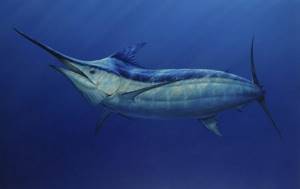
This giant, living in the waters of the Atlantic Ocean, has practically no natural enemies. And it would have been fruitful and multiplied unhindered, if not for the most terrible predator on Earth - man. To humans, blue marlin are just prey. One of the best countries for fishing, Cuba, even has a fishing tournament named after Ernest Hemingway. And it is dedicated specifically to fishing for blue marlin, which the famous writer loved to do during his lifetime.
Reef manta - 5.5 meters wide
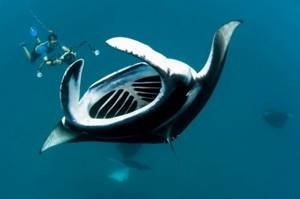
This is one of the largest fish living in the modern world. This species of stingray, also known as Manta alfredi, is commonly found in tropical and subtropical marine waters, but is absent from the eastern Pacific Ocean and western Atlantic Ocean.
The fish can weigh up to 1.4 tons, and its huge pectoral fins together with the body form a disk reaching a width of up to 5.5 m. Moreover, the length of the manta’s body is approximately 2.4 times less than its width
Manta alfredi primarily consumes zooplankton and does not pose a threat to humans. Previously, there were rumors that such a large stingray could swallow a person or crush him, “hugging” him with his fin wings.
“Generous catch”: top 7 biggest fish
1. The whale shark is the largest living species of shark and all modern fish. Size from 12 to 18 meters, weight can reach 34 tons (the weight of an average sperm whale). The number of teeth is 14,000 - 15,000, they are small and do not exceed 6 mm in length. She swims very slowly, her speed does not exceed 5 km/h. Despite its impressive size, the whale shark is not dangerous to humans, as it feeds mainly on plankton.

Japanese fishermen considered meeting a whale shark a good omen, so they practically did not catch it. Vietnamese fishermen called it with a respectful prefix, which can be translated as “Mr. Fish” (Vietnamese Ca Ong), which was also the name of the sea deity who brought good luck to the fishermen.
As of 2021, the whale shark is listed as an endangered species on the International Red List.
2. The giant (giant) shark is the second largest fish after the whale shark. The maximum length is 9 meters for males and 9.8 meters for females, weight is up to 4 tons. More than a quarter of a basking shark's weight is liver, which contains squalene.
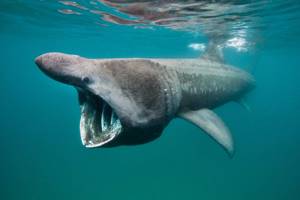
Squalene is a chemical substance that has a general strengthening, immunomodulatory, anti-inflammatory, membrane-protective, hypolipidemic, antiplatelet, hypotensive, antioxidant effect on the body, and has a positive effect on the functional state of the cardiovascular system and gastrointestinal tract.

The giant shark swims with its mouth open, its mouth looks like a pipe into which everything it comes across is sucked in. It is not dangerous to humans and has long been a valuable commercial catch.
Today, the International Union for Conservation of Nature has assigned this species the conservation status of Vulnerable.
3. Manta ray (giant sea devil) - the largest of the rays, is the only vertebrate animal with three pairs of functioning limbs. It got its nickname due to the presence of head fins, which are rolled into a tube and stick out forward like horns. The stingray's large wing-like fins reach seven meters. They can completely wrap a whale shark, the largest fish in the world.
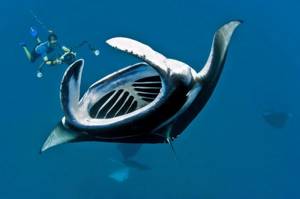
They feed on zooplankton and pose no danger to humans.
Manta rays are capable of making high jumps above water. Scientists suggest that in this way they get rid of parasites on the body, exchange signals in a school, or jam small prey - fish, squid, in order to then collect the crop in their mouths.

Another interesting fact is that manta rays are the most “brainy” fish in the World Ocean. The proportion of their brain (relative to body weight) is the largest of all fish known to science. The International Union for Conservation of Nature has assigned this species the conservation status of Vulnerable. The Maldives, Hawaii, and Ecuador have adopted a law prohibiting any fishing (targeted or as bycatch) and further sale of all species of stingrays.
4. Beluga is not only the largest of the sturgeons, but also the largest fish that is caught in fresh waters. Its weight reaches a ton, and its length exceeds four meters. The name is translated from Latin as “pig”, which very accurately fits its description - a thick round body, an abdomen, a short pointed nose, a huge mouth that covers the entire head, which is also surrounded by a thick lip. It also resembles a pig in its omnivorous nature; food of animal origin predominates in its diet.

Beluga is a long-lived fish, reaching an age of 100 years. Unlike Pacific salmon, which die after spawning, beluga can spawn many times in its life. Females lay black eggs. Before the revolution, the best grade of granular beluga caviar was called “Warsaw redistribution”, since most of its supplies went from Astrakhan to Warsaw, and from there abroad.

Today, the International Union for Conservation of Nature assigned the beluga the conservation status of “Critically Endangered Species.”
5. Moonfish , also known as sunfish and headfish, is the heaviest of modern bony fishes, reaching a length of up to three meters. She has a laterally compressed, tall and short body, which gives her an extremely unusual appearance. The shape of the body approaches that of a disk, and its length is approximately equal to its height. In the process of evolution, the caudal fin disappeared from the moon fish and was replaced by a tuberous pseudotail. It feeds mainly on jellyfish and other invertebrates.
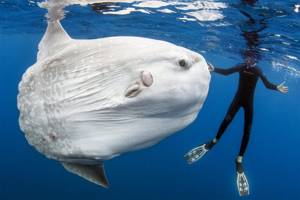
It is quite common to see sunfish lying on its side on the surface of the water. From time to time, its fins appear on the surface, and are sometimes mistaken for the dorsal fins of a shark. Despite its impressive size, it does not pose a danger to humans.
In EU countries there is a ban on the sale of fish products of this species.
6. Atlantic blue (blue) marlin is a predator from the sailfish family. Its scientific name is Makaira nigricans, which is translated from Latin as “dagger that turns black.” Females are four times larger than males (maximum body weight - 818 kg, length 5 m), males weigh only 160 kilograms. Life expectancy: females - 27 years, males - 18. They feed mainly on tuna and mackerel, and can also eat various cephalopods.

The high fat content of meat makes it an attractive commercial item in the market. Therefore, the International Union for Conservation of Nature has assigned this species the status of “Vulnerable”.
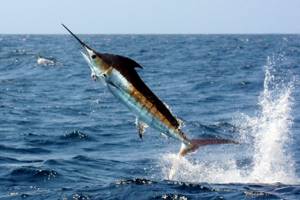
By the way, in Ernest Hemingway’s short story “The Old Man and the Sea,” a fisherman named Santiago fished for blue marlin off the coast of Cuba for three days. 7. The common catfish (European) is a large freshwater predatory fish. According to historical data, the largest catfish weighed 400 kg and its body length was 5 m. Modern records are somewhat more modest; in March 2011, the largest catfish in Europe was caught in Italy. The weight of the fish was 114 kg, and the length of the catfish was exactly 2.5 m.

Active nocturnal predator. During the day, he prefers to lie down in snags and other “strong places.” Before freeze-up, it gathers in pits in small groups of 5 to 10 individuals. In winter it is practically inactive.
There is a misconception that catfish feed only on carrion and spoiled foods. Actually this is not true. Adult catfish prefer live fish, freshwater animals and shellfish. However, there are known cases of attacks on waterfowl and small domestic animals.
Great white shark - 6.4 m
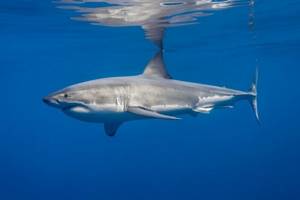
It is impossible to accurately measure the length of a great white shark, as there are few people willing to approach this living killing machine with a tape measure. According to unconfirmed information, the length of a great white shark can reach 10 meters, but the recorded record is 6.4 meters.
It may not be the biggest fish in the world, but it is certainly the most dangerous. Most shark-related attacks on humans are caused by white sharks. Most often it encounters people in coastal waters. By the way, Steven Spielberg’s famous film “Jaws” is just about a giant man-eating white shark.
Of course, in real life, people are not the favorite delicacy of white sharks, but unprovoked attacks on swimmers and fishermen by this dangerous predator are quite common.
The great white shark is the most feared predator in its ecosystem, although killer whales provide them with worthy competition, and sometimes even kill due to teamwork and speed of action. It’s a pity that killer whales are not fish, but mammals, otherwise they would take their rightful place on our list of the largest fish in the world. The video clearly shows the differences between a great white shark and a killer whale.
Saw-nosed ray - 7 m

These little-studied cartilaginous fish reach enormous sizes. However, most of their length consists of long, saw-like noses.
In appearance, the sawnose ray resembles a sawnose shark. However, the latter could well call the stingrays “fry” and argue that “it was better before.” And all because saw-nosed sharks appeared much earlier than saw-nosed rays - even at the border of the Jurassic and Cretaceous periods, while saw-nosed rays arose 60 million years later.
These fish are big fans of fishing in troubled waters, literally. Saw-tailed rays spend most of their lives at the bottom, not being interested in what is happening on the surface. And if young individuals prefer shallow water, then adult sawfish rays descend to a depth of 40 meters or more.
paddlefish
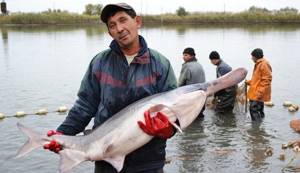
The paddlefish is a huge freshwater fish that lives primarily in the Mississippi River. Representatives of this species can also be found in a number of large rivers that flow into the Gulf of Mexico. The predatory paddlefish does not pose a threat to humans. However, he loves to eat individuals of his own species or other fish. And yet most of those who belong to this species are herbivores. They prefer to eat only grasses and plants that usually grow in the depths of fresh water. The maximum recorded body length of a paddlefish is 221 cm. The largest fish can gain weight up to 90 kg. The average lifespan of a paddlefish is 55 years.
Giant shark - 9.8 m

The third largest fish in the world. In the photo it looks menacing, but in reality it is a harmless creature whose diet consists of plankton. The giant shark feeds at the surface of the water, as if basking in the sun, hence its second name - “sunfish”.
Years of intensive commercial exploitation for food, the extraction of shark liver oil and shark fins, and many other factors have greatly reduced the population of this species.
Sunfish
Also "sunfish" "head fish", "common sunfish". Belongs to the “moon fish” family, leading the top heavy bony fish species on earth.
Lives in tropical and temperate waters.
The body is without scales, covered with thick, rough skin, which becomes softer closer to the tail. The color comes in different shades from dark brown to silver with a gray tint.
The body shape resembles a disk, the eyes and mouth of the fish are small relative to the size of the body. The caudal fin disappeared as a result of evolutionary changes, and in its place a cartilaginous plate formed, consisting of fin rays with rounded bones at the ends.
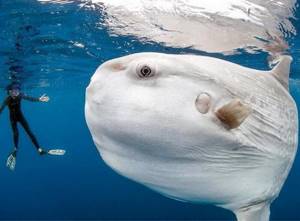
Ocean fish move slowly with the help of anal and dorsal fins; the pectoral fins serve as a stabilizer. A strong stream of water released from the oral cavity makes turns.
Due to its slowness and clumsiness, it feeds on plankton, larvae of other fish, sometimes jellyfish and small crustaceans.
The average size of modern adult fish (photos in the public domain): about two meters in length, the height of the fin tips exceeds 2.5 meters, weight up to 1000 kg. According to official data, giant specimens were caught, more than 3 meters in length, more than 4 meters in height, with a body weight exceeding two tons.
The sun fish partly owes its name to its favorite pastime, namely sunbathing on the surface of the water; this procedure is also preventive in nature, helping to get rid of parasites sticking to the skin.
Herring king - 11 m
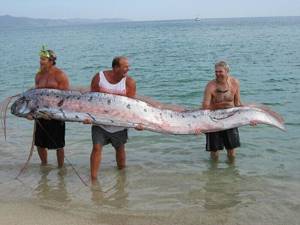
Move over, stingrays and sharks, there is a king fish in front of you by body length. The largest specimens caught reached 7 and 11 meters in length. The herring king was even included in the Guinness Book of Records as the longest living bony fish.
However, the fish received its name from Norwegian fishermen not for its body length, but because it was caught in schools of herring and the presence of a “crown” on its head, consisting of the elongated first rays of the dorsal fin.
Fourth place – Herring King

The silver giant got its name due to the red radiant formation on its head, reminiscent of a crown. The fish crosses the ocean expanses in the company of herring. It serves as the main dish on the menu of this amazing creation. Due to its ribbon-like snake-like body, the length of which reaches 6 meters, weight - 250 kg , and width - only 6 cm, the creature is called a belt fish. This amazing creature does not have a swim bladder; it moves through undulating (wavy) movements of the dorsal fin. The fish moves vertically, with its tail down.
The first description of the herring king appeared in 1771. Until now, ichthyologists consider it one of the least studied inhabitants of the deep sea. The fish, with a body devoid of scales and covered with tiny bony tubercles, lives in warm ocean waters at a depth of 50–200 meters, which makes studying the species much more difficult.
Whale shark - 20 m
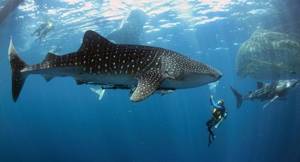
Here is the answer to two questions at once: what is the biggest fish and what is the biggest shark in the world? The whale shark weighs up to 21.5 tons and is the largest living fish species.
The whale shark is found in the open waters of warm tropical seas. These fish can live up to 70 years. Despite its size, this creature rarely poses a threat to humans and feeds mainly on plankton. The whale shark species is listed as endangered by the IUCN.
And if a photo of the world's largest fish can't show you the true gigantic size of a whale shark compared to a human, then let the video do it.
The largest river fish in Russia
Fishing is not only a test, but also an expectation of triumph. Every real fisherman wants to demonstrate his prowess by catching fish of incredible size. And some succeed, because among the freshwater fish of Russia there are individuals that are simply incredible in size and weight.

Bream
This species can be found in almost any fresh water body in Russia. Also found in northern and central Europe. The largest bream in history was caught in the territory of modern Finland, in Lake Visijärvi, in 1912 and weighed 11.6 kg. In Russia, abnormally large individuals were recorded in 1951 on the Vyatka River and in 2003 on Lake Ladoga. The weight of the caught bream was almost 6 kg. Average weight is 3-4 kilograms, length up to 40 cm. It is considered a valuable commercial fish. In the 30s of the 20th century, the catch of this species in our country reached 120 thousand tons per year.
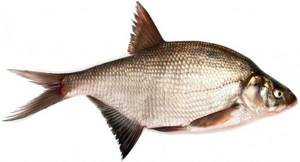
Burbot
The largest representative of the species was caught in Siberia in 1967. Its weight was 30 kg and its length was 120 cm. Other cases were also recorded. 1985, Lake Onega, a burbot weighing 16 kg was caught. 1910, Lake Ladoga, a fish weighing 10 kg was caught. Catching such large burbot is an incredible success, because their average weight is 3-4 kg.
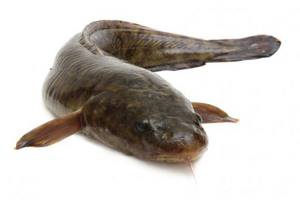
Burbot is a northern fish. It loves cold water, so it rarely appears in the south. Lives in Siberian rivers and Lake Baikal. Also found in northern Europe: Finland, the Baltic states, and the Leningrad region.
Pike perch
Pike perch is a predator, feeds on small fish and leads a secretive lifestyle. In places of active hunting, especially during the feeding process, it is not difficult to catch it. Due to its gluttony, it can be caught even by a novice fisherman. Pike perch is valued for its healthy dietary meat, containing a lot of protein.
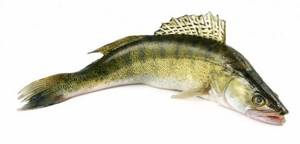
This type of fish can be found not only in fresh lakes and rivers of Russia, but also in the seas: Black, Baltic, Azov, Caspian. Usually the weight of caught pike perch is 8-10 kg. However, there is a documented case of catching a fish weighing 22 kg. They also say that the largest pike perch was caught in the last century on the Volga River, its weight was 40 kg.
lake salmon
Lake salmon is not even a species or subspecies, but a morph of Atlantic salmon. Morph is a type of animal that has persistent differences within a species or population; this category includes melanists, albinos, local varieties, and so on. The main difference between lake salmon and Atlantic salmon is that they feed in lakes rather than in salt water bodies. The young of such fish do not go to the sea when they grow up; they live in the lake and then spawn in the rivers that flow into it. In Russia, such salmon live in lakes Ladoga and Onega, Segozero and a number of other northern reservoirs. You can fish only within Lake Onega; the remaining populations are listed in the Red Book.
Lake salmon are smaller in size than sea salmon, with an average weight of 3-4 kg. The maximum officially noted is 7 kg, but fishermen claim otherwise, saying that they have caught fish weighing up to 10 kg or more. However, such statements should be treated with caution, because Baltic salmon, for example, also goes to spawn through Ladoga and Neva - rivers flowing into Lake Ladoga. And when switching to freshwater mode, the fish changes color; representatives of the oceanic stock are easily confused with “indigenous” freshwater inhabitants of larger sizes. Such individuals can also end up in Lake Onega, and a person may encounter an anadromous fish, considering it to be local freshwater.
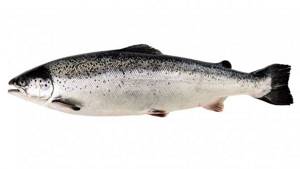
Carp
Prized for its tasty, fatty meat. The carp feeds on algae. He just swims with his mouth open and eats everything that comes in his way. If it were not for natural enemies: catfish, then carp, which lives on average 10-15 years, could grow to incredible sizes. The largest carp was caught in 1937, in Belgium. The monster, 3.5 m long and weighing 190 kg, terrorized Lake Ostend for several years. In Russia, a record carp was caught on the Voronezh River; it weighed 68 kg. Officially, the weight of the carp reaches 14 kg. Carp is a common carp.
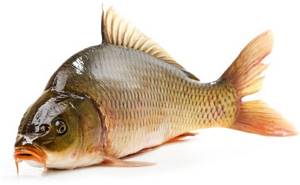
Pike
The predatory pike is familiar to everyone since childhood. She is widespread throughout Russia, so she is often found as a character in folklore. Fishermen also know many incredible stories about pike. It is believed that the largest pike was caught in the 15th century, in 1497. Her weight was 140 kg, and her body length was about 6 meters. It was possible to determine the age of the fish, since it was ringed.
It was established that the mark corresponded to the era of the reign of Frederick the Second, ruler of the Roman Empire. The pike was ringed around 1230 and released. It turns out that she lived 270 years before she was caught by a person again. It is officially believed that the weight of pike reaches 16 kg.
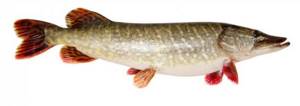
White amur
The fish was discovered in the Amur River, which is reflected in its name. The herbivorous grass carp turned out to be unpretentious and lends itself well to breeding in fish farms. Later it was spread throughout Russia, brought to Kazakhstan, Belarus, and Ukraine. Now the fish is actively caught in China. Grass carp are also bred in the USA.
The average weight of the fish is 30 kg, and the length is 120 cm. These are official data, but fishermen say that they usually manage to catch grass carp with a maximum weight of up to 25 kg. There is a documented case when on the Volga River, with the help of a seine, individuals of grass carp were caught, the weight of which exceeded 45 kg.
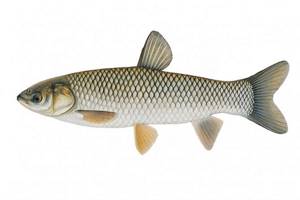
Taimen
A native Siberian fish, it belongs to the salmon species. Foreign fishermen call taimen “Russian salmon.” For many years, fishing was carried out barbarously and significantly reduced the number of the species. Today, taimen is listed in the Red Book of Russia, and its catch is limited. It is believed that the weight of ordinary taimen ranges from 50 to 70 kg. But the size of an individual directly depends on its habitat. Statistics on taimen living in the Yenisei River say that the average weight of the fish is 78 kg. In 1943, the largest representative of the species was caught on the Kotui River. Its weight is 105 kilograms and its length is 2 meters.
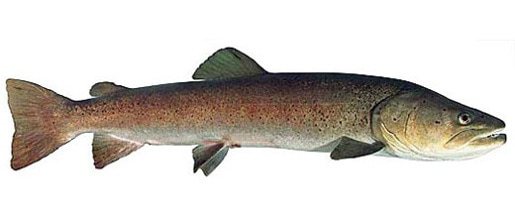
Catfish
The most legendary fish, surrounded by many myths. Catfish are predators. Their diet consists of more than just small fish. Large old catfish can hunt ducks sitting on the water, animals that come to drink, and small pets. Catfish live a very long time and grow throughout their lives. They say that in the 19th century, in Russia, a catfish weighing 400 kg was caught. The officially registered catfish that was caught weighed 306 kg, was more than 3 meters long and was about 80 years old. Modern catfish weighing over 100 kg are extremely rare.
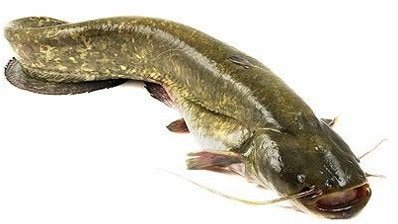
Kaluga
The kaluga fish is a close relative of the beluga (a freshwater fish of the beluga genus, the sturgeon family), and spends its entire life in fresh water. It can be found in the Amur River basin, in a temperate climate zone. On average, the fish reaches a length of 2.5-3 m and a weight of 150 kg. The largest documented individual weighed 382 kg and was 5.5 meters long.

It is believed that the fish can grow up to 8 m and weigh up to 1.5 tons. Kaluga is a predator, feeding mainly on bottom fish. Large kaluga eat chum salmon, pink salmon and even prey on smaller individuals of their own species. Due to uncontrolled fishing, it was on the verge of extinction, so in the mid-20th century it was taken under state protection. Now Kaluga is successfully restoring its population.
The largest river fish in Russia...was
Beluga is the largest river fish in Russia. Lives in both sea and fresh water. Because of its enormous size it is called the “king fish”. The beluga grows continuously throughout its life. The largest individuals reached a length of 8 meters and weighed about two tons. In 1827, the capture of a beluga weighing 1.5 tons was documented. Almost a hundred years later, in 1922, a fish weighing 1224 kg was caught at the mouth of the Volga. The national museum of the Republic of Tatarstan contains a beluga skin 4 m long; the weight of the fish when caught was more than a ton.










